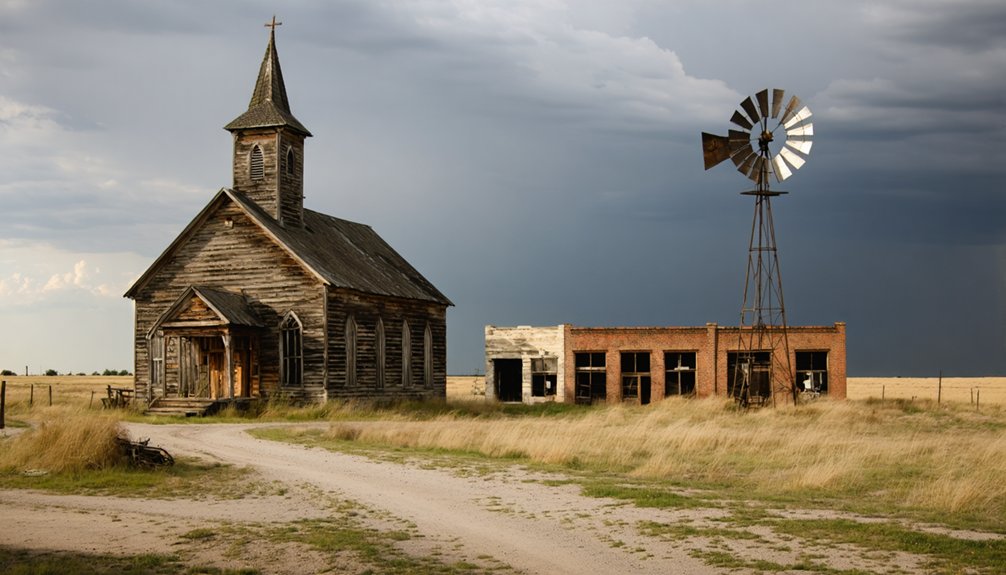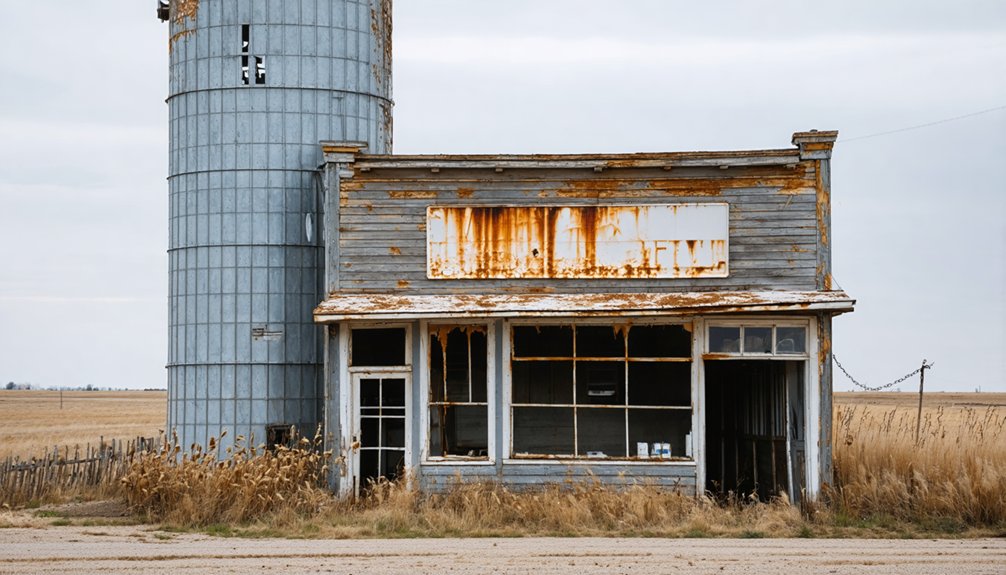You’ll find numerous abandoned settlements across the Great Plains where time has seemingly stood still. Charbonneau, North Dakota grew alongside railroad expansion but faded with modern transportation. Tincup, Colorado boomed with gold fever before crashing. Treece, Kansas thrived then collapsed when mining poisoned the land. Nicodemus preserves a rare Black settlement history, while towns like Bodie represent agricultural speculation gone wrong. Each weathered building and empty street reveals profound economic and social transformations of frontier America.
Key Takeaways
- Charbonneau, North Dakota thrived as a railroad town until automobiles and modern utilities led to its decline by the 1950s.
- Tincup, Colorado boomed as a gold mining settlement before the 1890s silver crash turned it into a weathered ghost town.
- Treece, Kansas supplied vital metals for both World Wars before environmental devastation led to a complete government buyout by 2012.
- Nicodemus, Kansas remains the only surviving all-Black township from post-Reconstruction, now home to fewer than 20 residents.
- Many North Dakota ghost towns emerged during the wheat boom of 1880s-1900s, later abandoned during agricultural decline and the Dust Bowl.
Charbonneau, North Dakota: The Town That Rails Forgot
When the Great Northern Railroad stretched its steel ribbons across western North Dakota in 1913, the small settlement of Charbonneau sprang to life alongside the newly constructed bridge over the Yellowstone River.
Named after Toussaint Charbonneau of Lewis and Clark fame, this McKenzie County outpost quickly developed into a hub of railroad history.
From humble beginnings, a prairie settlement rose to become a vital link in the great western railroad expansion.
You’d have found a thriving community by 1920, when 125 residents supported a bank, newspaper, blacksmith, hotel, and even the county’s first creamery.
The depot bustled with activity as trains connected Charbonneau to Alexander and Watford City. The town’s main street was a simple dirt road with deep ditches designed for drainage alongside the railroad tracks.
But freedom brought change. As automobiles, electricity, and telephones reached the prairie, the town’s importance faded.
Population decline followed swiftly—by the 1950s, the school closed, businesses shuttered, and the depot fell silent. The post office, once a vital community center, continued operations until William Bell, the town’s last postmaster, closed its doors permanently in 1967.
Tincup, Colorado: Where Gold Dreams Turned to Dust
While Charbonneau, North Dakota quietly faded alongside its abandoned railway, another town’s story unfolded 700 miles southwest in Colorado’s rugged Sawatch Range.
Tincup history begins with Jim Taylor’s 1859 discovery of placer gold, carried in the tin cup that would name the settlement. By 1882, the town transformed from Virginia City to Tincup, boasting 2,000 residents at its peak. You’d have found a thriving hub of saloons and smelters perched above 10,000 feet.
Unlike many mining settlements, Tincup’s reputation for violence became legendary—its cemetery filled with lawmen who challenged the controlling underworld. The historic cemetery still contains distinct Protestant, Catholic, and Jewish sections that reflect the diverse population of the mining era.
After the 1890s silver crash, Tincup mining operations collapsed. Much like St. Elmo’s transformation from a 2,000 resident boomtown to a ghost town, Tincup’s population rapidly declined. By 1918, the last elections were held as the town emptied.
Today, this semi-ghost town‘s weathered cabins stand as monuments to freedom seekers whose golden dreams turned to dust.
Treece, Kansas: A Mining Community Swallowed by Time
Unlike Tincup’s violent gold rush saga, Treece, Kansas emerged in 1917 as a lead and zinc mining community that would follow a different path to abandonment.
What began with a broken-down truck’s chance discovery transformed into a booming settlement that supplied critical metals for both World Wars. By the 1960s, the minerals had depleted, leaving behind a toxic legacy that would ultimately seal the town’s fate. The small settlement became a major supplier of essential metals used in ammunition during both world conflicts. The compact town covered merely four by five blocks in the southeast corner of Kansas.
- Lead poisoning ravaged local children playing in contaminated “chat” piles
- Environmental devastation earned EPA Superfund designation in 1983
- Government buyout program evacuated remaining residents by 2012
- Mining legacy left orange-tinted toxic waters throughout the region
- Population collapsed from thriving boomtown to just 138 before evacuation
Where industry once flourished, you’ll now find only empty lots reclaimed by prairie grass—nature slowly erasing mankind’s brief industrial footprint.
Nicodemus, Kansas: The Prairie’s African American Settlement
As the rolling prairie winds sweep across western Kansas, Nicodemus stands as a tribute to African American determination and hope in the post-Civil War era. Founded in 1877 by six Black Kansans and one white developer, this settlement offered freedom when opportunity was scarce elsewhere.
When you visit today, you’re walking where nearly 500 Kentucky freedmen established new lives between 1877-1878. W. H. Hill led recruitment efforts that brought almost 300 settlers from Lexington to the emerging community.
You’ll find echoes of their community resilience in the churches founded by Reverends Lee and Hickman, which anchored settlers through harsh plains conditions.
Though African American migration brought the population to 350 at its peak, railroad bypasses triggered decline. Settlers arrived with dreams of prosperity only to discover that many promotional claims were greatly exaggerated.
Now home to fewer than 20 residents, Nicodemus remains the only surviving all-Black township from the post-Reconstruction westward movement, its legacy preserved in its determined spirit.
Bodie, North Dakota: When the Wheat Fields Failed
Despite popular misconception, Bodie never actually existed in North Dakota’s wheat belt—the name belongs to California’s famous gold rush ghost town.
However, North Dakota’s prairie landscape is dotted with authentic ghost towns that followed a similar arc of hope and abandonment, fueled by wheat speculation rather than gold fever.
You’ll find these forgotten settlements along abandoned rail lines, where ambitious farmers once staked their futures on fertile soil and favorable markets. The term “Bodie” requires careful disambiguation since it refers to multiple places and people throughout history.
- Abandoned grain elevators stand as prairie sentinels marking where communities once thrived
- Towns emerged rapidly during the 1880s-1900s wheat boom, only to collapse when prices plummeted
- Agricultural decline accelerated during the Great Depression and Dust Bowl years
- Young people fled to cities, leaving aging populations behind
- Single-industry economies proved fatally vulnerable to market shifts and harsh climate challenges
Unlike North Dakota’s agricultural towns, California’s Bodie experienced a gold boom from 1877 to 1881 with peak population reaching approximately 8,000 residents before its eventual decline.
Frequently Asked Questions
What Preservation Efforts Exist for Ghost Town Artifacts?
You’ll find dedicated artifact conservation efforts through non-profit preservation funds, while universities document historical items through archaeological fieldwork, capturing the temporal evolution of settlement patterns across abandoned frontier communities.
How Did Native American Communities Interact With These Towns?
Like Wi-Fi hotspots, prairie towns became cultural exchanges hubs where you’ll find Native Americans establishing trade relations, defending territories, creating social networks, and adapting to your settlements’ changing economic patterns over time.
Can Visitors Legally Explore Abandoned Prairie Buildings?
You can’t legally enter these buildings without permission. Abandoned property laws require owner consent, while urban exploration ethics demand respecting boundaries across temporal settlement patterns of the prairie landscape.
What Psychological Effects Did Isolation Have on Prairie Settlers?
Scandinavians faced 40% higher rates of mental distress. You’d experience isolation effects like depression and withdrawal, while community dynamics deteriorated as settlers scattered across vast prairies, creating temporal and spatial fractures in your social connections.
Did Any Forgotten Towns Successfully Reinvent Themselves?
Yes, you’ll find towns that transformed through heritage tourism, private investment, and ecological restoration. Their town revitalization efforts created distinctive identities and implemented economic strategies where your frontier spirit can flourish again.
References
- https://www.coloradolifemagazine.com/printpage/post/index/id/172
- https://archeology.uark.edu/wp-content/uploads/2015/04/RS47-Northern-Plains-Overview.pdf
- https://writinforthebrand.com/booming-settlement-to-ghost-town-whispers-of-the-living-history-of-charbonneau/
- https://history.sd.gov/docs/Complete_State_Plan_withFigures.pdf
- https://www.geotab.com/ghost-towns/
- https://theplanninglady.com/2020/01/19/reviving-the-great-plains-a-new-future-for-small-towns/
- https://www.legendsofamerica.com/gt-emergingghosttowns/
- https://en.wikipedia.org/wiki/Great_Plains
- https://en.wikipedia.org/wiki/Prairie_madness
- https://boards.straightdope.com/t/abandoned-prairie-towns-what-caused-it/567962



